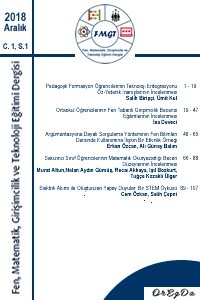7. Sınıf Öğrencilerinin Çoklu Temsil Temelli Öğretim Sürecindeki Zihnin Geometrik Alışkanlıklarının İncelenmesi
Çoklu Temsil, Zihnin Geometrik Alışkanlıkları, Geometri Öğretimi
Investigation of Geometric Habits of Mind in the Multi-Representation Based Learning Process of 7th Grade Students
___
- Altıkardeş, E., & Yiğit-Koyunkaya, M. (2022). Matematik öğretmenliği lisans öğrencilerinin geometrik alışkanlıklarının incelenmesi: Trigonometri örneği. Muğla Sıtkı Koçman Üniversitesi Eğitim Fakültesi, 9(2), 514-540. DOI: 10.21666/muefd.1032938
- Baki, A. (2006). Kuramdan uygulamaya matematik eğitimi. (3. Baskı) Trabzon: Derya Kitabevi.
- Baykul, Y. (2002), İlköğretimde matematik öğretimi. Ankara: Pegem Yayıncılık.
- Bülbül, B. Ö., & Güven, B. (2020). Öğretmen adaylarının geometrik düşünme alışkanlıklarının değişimi. Pamukkale Üniversitesi Eğitim Fakültesi Dergisi, 48, 431-453. Doi:10.9779/pauefd.513220
- Czarnocha, B., & Maj, B. (2008). A teaching experiment. In B. Czarnocha (Ed.), Handbook of mathematics teaching research -a tool for teachers- researchers (pp. 47–58). Poland: University of Reszów.
- Dawson, C. (2009). Introduction to research methods: A practical guide for anyone undertaking a research project. Oxford: How to Books Ltd.
- Driscoll, M., Wing DiMatteo, R., Nikula, J., & Egan, M. (2007). Fostering Geometric Thinking: A Guide for Teachers, Grades 5-10. Portsmouth, NH: Heinemann
- Ergene, B., (2011). Matematik öğretmen adaylarının türev kavramına ilişkin teknolojik pedagojik alan bilgilerinin çoklu temsiller bileşeninde incelenmesi. (Yayımlanmamış Yüksek Lisans Tezi). Marmara Üniversitesi, İstanbul.
- Goldin, G. A. (1998). Representations, learning, and problem solving in mathematics. Journal of Mathematical Behavior, 17(2), 137-165.
- Govender, R. G. & Govender, D. W., (2020), Learning Geometry Online: A Creative Individual Learning Experience , International Journal of eBusiness and eGovernment Studies, 12 (2): 151165. Doi: 10.34111/ijebeg.202012205
- Kaput, J., J. (1998). Representations, inscriptions, descriptions and learning: A kaleidoscope of windows. Journal of Mathematical Behavior, 17(2), 265-281.
- Köse, Y.N., & Tanışlı, D. (2014). Sınıf öğretmeni adaylarının geometrideki zihinsel alışkanlıkları. Kuram ve Uygulamada Eğitim Bilimleri. 14(3). 1203-1230.
- McKendree, J., Small, C. & Stenning, K. (2002). The role of representation in teaching and learning critical thinking. Educational Review, 54 (1), 1–10.
- National Council of Teachers of Mathematics (NCTM) (2000). Principles and standards for school mathematics. Reston, VA: NCTM.
- Otterbum, M.K. & Nicholson, & A.R. (1976). The language of CSE mathematics. Mathematics in School. (5),18-20.
- Steffe, L. P. & Thompson, P. (2000). Teaching experiment methodology: Underlying principles and essential elements. In A. Kelly & R. Lesh (Eds.), Handbook of Research Design in Mathematics and Science Education (pp.267 – 306). Mahwah, NJ: Lawrence Erlbaum Associates.
- Straker, A. (1993). Talking Points in Mathematics. Cambridge: Cambridge University Press.
- Şeker, B., H. & Erdoğan, A. (2017). GeoGebra yazılımı ile geometri öğretiminin geometri ders başarısına ve geometri öz-yeterliğine etkisi. Uluslararası Toplum Araştırmaları Dergisi. 7 (12), 82-97.
- Tolga, A., & Cantürk-Günhan, B. (2019). Ortaokul matematik öğretmenlerinin zihnin geometrik alışkanlıklarının belirlenmesi. Batı Anadolu Eğitim Bilimleri Dergisi, 10(1), 37-56.
- Ubuz, B. (1999). 10. ve 11. sınıf öğrencilerinin temel geometri konularındaki hataları ve kavram yanılgıları. Hacettepe Üniversitesi Eğitim Fakültesi Dergisi, 17(17).
- Uygan, C. (2016). Ortaokul öğrencilerinin zihnin geometrik alışkanlıklarının kazanımına yönelik dinamik geometri yazılımındaki öğrenme süreçleri. (Yayımlanmamış Doktora Tezi). Anadolu Üniversitesi, Eskişehir.
- Van de Walle, J.A., Karp, K. S., & Bay-Williams, J.M. (2007). Elemantary and middle school mathematics: Teaching developmentally (7th Ed.). New York, NY: Person Education.
- Van Hiele, P. (1999). Developing geometric thinking through activities that begin with play. Teaching Children Mathematics. February 1999, 310-316.
- Yıldırım, A., & Şimşek, H. (2008). Sosyal Bilimlerde Nitel araştırma Yöntemleri (6. Baskı). Ankara: Seçkin Yayıncılık.
- ISSN: 2667-5323
- Yayın Aralığı: Yılda 3 Sayı
- Başlangıç: 2018
- Yayıncı: Oregda
Arife TOLGA, Berna CANTÜRK GÜNHAN
Bir Soyutlama süreci; RBC+C ile ilgili Alanyazının Tematik Analizi
Rümeysa BEYAZHANÇER, Murat ALTUN
Batıl İnançların Fen Bilimlerindeki Bilgilerle Çatışan ve Çakışan Boyutlarını Keşfetmek
Emine ÇEPNİ, Dila Rabia DEMİR, Ceylin Heja ÖZSUCU, Elif Meryem DUMAN
